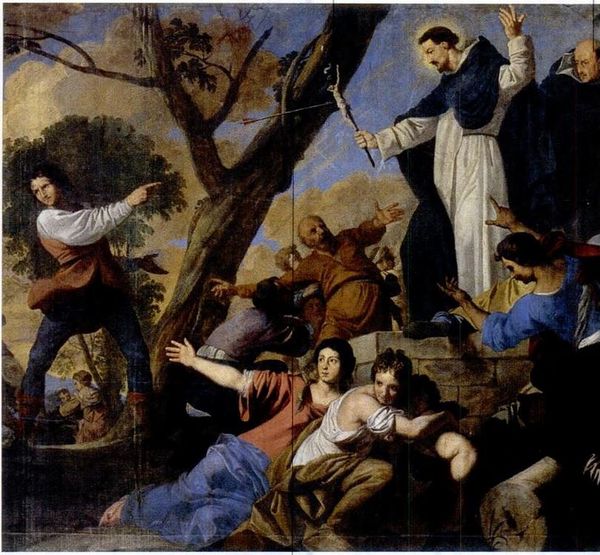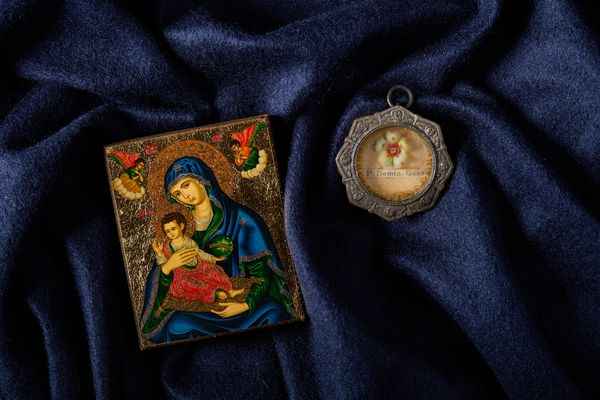At fourteen years of age, Dominic was sent to the Premonstratensian monastery of Santa María de La Vid and subsequently transferred for further studies in the schools of Palencia. In Palencia, he devoted six years to the arts and four to theology. In 1191, when Spain was desolated by famine, young Dominic gave away his money and sold his clothes, furniture, and even precious manuscripts to feed the hungry. Dominic reportedly told his astonished fellow students, "Would you have me study off these dead skins when men are dying of hunger?"
At the age of 24, Dominic was ordained as a priest and subsequently joined the canonry of the Cathedral of Osma. In 1198, Don Martin de Bazan, the Bishop of Osma, having reformed the chapter, made Dominic the subprior of the chapter. In 1203 or 1204 he accompanied Diego de Acebo on a diplomatic mission. During their return journey, they met with Cistercian monks who had been sent by Pope Innocent III to preach against the Cathars, a Christian religious sect with gnostic and dualistic beliefs which the Catholic Church deemed heretical. Dominic and Diego de Acebo attributed the Cistercians' lack of success to their extravagance and pomp compared to the asceticism of the Cathars. They decided to adopt a more ascetic way of life and began a program in the south of France to convert the Cathars.
In late 1206, Acebo and his group established themselves at the Monastery of Our Lady of Prouille in France. Bishop Foulques of Toulouse allowed them to use the church. The house was intended partly as a refuge for women who had previously lived in Cathar religious houses, and partly the first established base of operations. The first nuns of Prouille lived for several months at Fanjeaux, because the buildings at Prouille were not yet habitable. Dominic gave them the Rule of St. Augustine.
Dominic % The Rosary
Catholic-Cathar debates were held at Verfeil, Pamiers and Montréal. Ordered by the Pope to return to his diocese, Diego de Acebo died at Osma in December 1207, leaving Dominic alone in his mission. According to Dominican tradition, in 1208 Dominic experienced a vision of the Blessed Virgin Mary in the church at Prouille, during which she gave him a rosary. This gave rise to the title Our Lady of the Rosary.
The spread of the Rosary is attributed to the preaching of the Dominicans. For centuries the Rosary has been at the heart of the Dominican Order. Pope Pius XI stated, "The Rosary of Mary is the principle and foundation on which the very Order of Saint Dominic rests for making perfect the life of its members and obtaining the salvation of others."
The Dominican Order of Preachers
In 1215, Dominic established himself, with six followers. Dominic saw the need for a new type of organization to address the spiritual needs of the growing cities of the era, one that would combine dedication and systematic education, with more organizational flexibility than either monastic orders or the secular clergy. He subjected himself and his companions to the monastic rules of prayer and penance; Bishop Foulques gave them written authority to preach throughout the territory of Toulouse.
Also in 1215, the year of the Fourth Lateran Council, Dominic and Foulques went to Rome to secure the approval of Pope Innocent III. Dominic returned to Rome a year later and was finally granted written authority in December 1216 by the new pope, Honorius III, for him to form the "Order of Preachers".
Although he traveled extensively to maintain contact with his growing brotherhood of friars, Dominic made his headquarters in Rome. In 1219, Pope Honorius III invited Dominic and his companions to take up residence at the ancient Roman basilica of Santa Sabina, which they did by early 1220. Before that time the friars had only a temporary residence in Rome at the convent of San Sisto Vecchio, which Honorius III had given to Dominic circa 1218, intending it to become a convent for a reformation of nuns at Rome under Dominic's guidance. The official foundation of the Dominican convent at Santa Sabina with its studium conventuale, the first Dominican studium in Rome, occurred with the legal transfer of property from Pope Honorius III to the Order of Preachers on 5 June 1222, though the brethren had taken up residence there already in 1220. The studium at Santa Sabina was the forerunner of the studium generale at Santa Maria sopra Minerva. The latter would be transformed in the 16th century into the College of Saint Thomas, and then in the 20th century into the Pontifical University of Saint Thomas Aquinas, Angelicum sited at the convent of Saints Dominic and Sixtus.
Dominic arrived in Bologna on 21 December 1218. A convent was established at the Mascarella church by Reginald of Orleans. Dominic abstained from meat, observed stated fasts and periods of silence, "elected the worst accommodations and the meanest clothes, and never allowed himself the luxury of a bed. When traveling, he beguiled the journey with spiritual instruction and prayers. Dominic frequently traveled barefoot and that rain and other discomforts elicited from his lips nothing but praises to God.
Dominic died at the age of fifty-one, exhausted with the austerities and labors of his career. He had reached the convent of St Nicholas at Bologna, Italy, weary and sick with a fever. Dominic made the monks lay him on some sacking stretched upon the ground and that the brief time that remained to him was spent in exhorting his followers to have charity, to guard their humility, and to make their treasure out of poverty. He died at noon on 6 August 1221. His body was moved to a simple sarcophagus in 1233. Under the authority of Pope Gregory IX, Dominic was canonized in 1234. In 1267 Dominic's remains were moved to the shrine, made by Nicola Pisano and his workshop for the Church of St. Dominic in Bologna.
Credits:
Discriptions of saints lives and biographies have been excerpted, summarized, or compiled from
Franciscan Media,
CatholicSaints.Info,
Catholic Online, and
Wikipedia.

